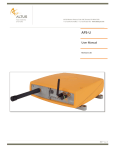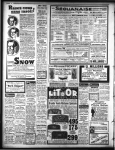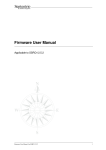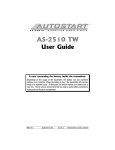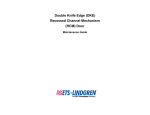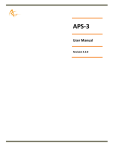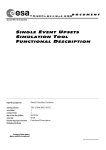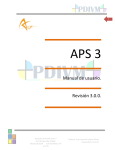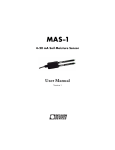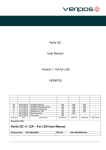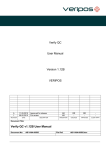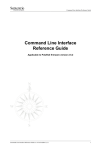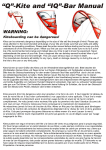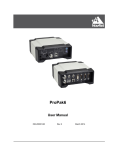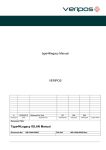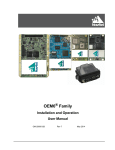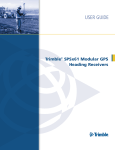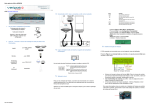Download Maritime test campaign methodology
Transcript
Test methodology DL 3: Selection of receivers to be tested (+rationale supporting the choice) DL 4: Selection of Test scenarios + Test sites DL 5: Presentation of the test procedure and test data to be gathered “Assessment of EGNOS potential in the maritime and inland waterways transport sector” Specific Contract No.3 under DG ENTR’s Framework Contract ex TREN/G4/475-1-2009 Company Confidential and for internal use only Reference EC_SCNo3_HLD_TM Created Date | By v.0.1, 2012-02-29, Andreas Kroier Last Modified Version | Date | By v.1.1, 2012-04-12, Andreas Kroier Recipients European Commission Michael Mastier Av. d'Auderghem 45 - BREY 4/244 1049 Brussels Belgium Responsible DKE Aerospace Germany GmbH Andreas Kroier Graf-von-Soden-Straße H10 88090 Immenstaad Germany Tel: +49 7545 8 8297 Fax: +49 7545 8 8296 www.dke-aerospace.com © DKE Aerospace 2012 This document contains proprietary information and may not be reproduced in any form whatsoever, nor may it be used by or its contents divulged to third parties without written permission of DKE Aerospace Germany GmbH. Any hard copy of this document or unlocked soft copy must be regarded as an uncontrolled copy. Reference Documents Reference RD1 RD2 RD3 RD4 RD5 RD6 RD7 Title u-blox 6 Receiver Description Including Protocol Specification, FW 7.03, GPS.G6-SW10018-A Trimble SPSx51Modular GPS Receivers User Guide, Version 3.70, Revision A, August 2008 EVK-6 u-blox Evaluation Kits User Guide, GPS.G6-EK-10040-1 SBF Reference Guide, V.1.9.0 Firmware User Manual, Rev.0 Operators Manual GPS Navigator GP-150, OME-44400-C RTCA DO-229D Company Confidential DKE Aerospace Release Date 01.04.2011 10/2008 2011 16.07.2010 07.09.2010 18.02.2010 13.12.2006 2 of 32 Table of Content Reference Documents ......................................................................................................................................................... 2 Table of Content ................................................................................................................................................................. 3 1 Introduction ....................................................................................................................................................... 4 1.1 Interference sources .......................................................................................................................................... 4 1.2 Handling of two antennas ................................................................................................................................. 4 1.3 Test route and timing ........................................................................................................................................ 5 2 Equipment ......................................................................................................................................................... 9 2.1 Splitting of the antenna signals ....................................................................................................................... 10 2.2 Signal conditioning .......................................................................................................................................... 12 2.3 DKE antenna mast ........................................................................................................................................... 13 3 Receiver settings.............................................................................................................................................. 15 3.1 GPS position – RX1........................................................................................................................................... 15 3.2 Low-end receiver EGNOS position – RX2 ......................................................................................................... 16 3.3 Medium-end receiver EGNOS position – RX3 .................................................................................................. 16 3.4 IALA beacon position – RX5 ............................................................................................................................. 16 3.5 High-end receiver EGNOS position (RX4) ........................................................................................................ 17 3.6 Reference position (RX6) ................................................................................................................................. 19 4 Data logging ..................................................................................................................................................... 20 4.1 GPS position – RX1........................................................................................................................................... 20 4.2 Low-end EGNOS position – RX2 ....................................................................................................................... 20 4.3 Medium-end receiver EGNOS position – RX3 .................................................................................................. 21 4.4 High-end receiver EGNOS position (RX4) ........................................................................................................ 21 4.5 IALA beacon position – RX5 ............................................................................................................................. 21 4.6 Reference position (RX6) ................................................................................................................................. 22 5 Data analysis .................................................................................................................................................... 23 6 Raw data recording (RX4 or RX6)..................................................................................................................... 25 6.1 Settings ............................................................................................................................................................ 26 6.2 Integrity recording ........................................................................................................................................... 28 7 Tests - per test site .......................................................................................................................................... 30 7.1 Lake of Constance – Preliminary test .............................................................................................................. 30 7.1.1 Timing .............................................................................................................................................................. 31 7.1.2 Route ............................................................................................................................................................... 31 Company Confidential DKE Aerospace 3 of 32 1 Introduction The purpose of this document is to provide a detailed test methodology for the test carried out under this specific contract for the European Commission, and therefore corresponds to the deliverable “DL 5: Presentation of the test procedure and test data to be gathered”. 1.1 Interference sources This section is not intended for a general discussion about GNSS/SBAS interference since there are multiple papers available discussing these issues. The interference sources on the ship identified are radar and radio, even though some of the ships probably do not have radar aboard. Sonar and other typical equipment present on ships are considered to have less influence. The radar aboard ships depends very much on the ship type and its usage. The transmission power therefore varies from some milliwatt on private ships to kilo watts on high-sea ships. In order to avoid disturbance of the test equipment by radar, the antennas shall be placed as far away from the radar as possible. Preferably the navigation antennas are also placed on the highest point of the ship. With the mast detailed in section 2.1, this can easily be realized. Nevertheless the aim shall be to stay as low as possible to best reflect the real world scenario. This will be the case if the mast is not used but the antennas are mounted directly on structures available on the ship. It is important that the antennas are not place directly in the radar beam. The boats to be used are intended to be similar as shown in Figure 1. This type of boats is considered to be representative for the private ship owner, since it is not too big but also not too small and allows the tests to be carried out with the equipment required and providing space for the personnel present. Figure 1 Boat types Since the tests shall reflect a likely usage scenario no active measures against interference are taken, expect from the antenna placement. This is considered a valid approach since it is thought to be what the private ship owner would do. 1.2 Handling of two antennas The introduction of two antennas through the update of the task specification – as outlined in the proposal – leaves the difficulty of the exact determination of the position of the medium-end antenna. It requires the question to be clarified how the second antenna can be referred to the reference antenna, or in other words how the reference track can be compared to the track recorded through the second antenna. The only way to align the two tracks would be that the system provides heading information. Since not all receivers are available at the submission of this draft of the test methodology it cannot be stated whether this will be the case or not. At the time of writing it seems unlikely that a receiver would provide sufficiently accurate heading information, since heading is usually provided through duplicate antenna systems. Figure 2 shows the situation. What can be seen that by calculation the position of the medium antenna the missing angle information would lead to an error, indicated as red position marked “Wrong”. Company Confidential DKE Aerospace 4 of 32 Known A B Known Wrong B C Known A Calc. B A Calc. Known Wrong Figure 2 Medium-end antenna position determination A way to calculate the position of the medium-end antenna is the course over ground. The quality of this computed “quasi” reference position will be assessed at the preliminary test. In any case at the start of the measurement the antenna positions will be determined through the reference antenna. As shown in Figure 3 the antenna mast will be turned by 180° to determine the position of both antennas. The beacon antenna will be placed in the middle of the antenna array. The distances between the antennas are fixed. Therefore the measurement as a side effect also provides an assessment of the reference position accuracy, since the distance between the antennas is fixed being one meter. A A B C C B B C A Reference antenna Medium-end antenna Beacon antenna Figure 3 Antenna position determiation at start The distance between the antennas on the structure used is chosen to be possible on a small ships mast like the ones shown, but also to avoid the antennas interfering with each other (in case they would be too close). Details for the antenna mounting are discussed in section 2.2. The following section introduces the equipment used. The details on each receiver are entered only after the validation and test with the real receiver, the section shall not be a copy of the manuals. 1.3 Test route and timing The test route chosen is a straight line from the departure point to the end-point selected with a distance of about 15km (~8.09 nautical miles). Depending on the speed of the boat available, the test route will be extended by the same straight line perpendicular to the first part of the test route, see Figure 4. Company Confidential DKE Aerospace 5 of 32 2,3 4,5,8,9 4,5 6,7,10,11 1,6 1,2,3,4 1,2,3,12 15km 7.5km 5 km/h = 2.7 knots Each indicated part Total 15km 25km 15 km/h = 8.1 knots Each indicated part ~ 60 min Total 6h ~ 90 min 6h 25km 12.5km 25 km/h = 13.5 knots Each indicated part ~ 30 min Total 6h Figure 4 Route/test path As shown in Figure 4 the route is depending on the speed of the boat. The basis is the part of the route always indicated as “1”. For the maritime this part will in any case be repeated for all scenarios. In order to more efficiently use the time available on the test day, this basic scenario will be extended with the “vertical” tests indicated to vary the test route. Obviously on inland waterways the scenario cannot be like shown in Figure 4, but rather has to follow the path of the waterway. Therefore a straight line is intended to be followed if possible. In any case on the inland waterway the route will be repeated (following the same course) in order to create the repeated measurement data – nevertheless this can only be done if the traffic and rules allow for it. The distance is a result of the boat type and the speed it provides along with the time available for a test. Table 1, Table 2 and Table 3 detail the planned timeline for tests on a full-day and an additional half-day test. The full-day test is guaranteed on each test site. The half-day test will be done if the test-site schedule allows for it. The timing is a general timing that is valid for the test sites. It can vary depending on circumstances such as delayed flights etc. and can be extended to increase the test time. Time - start 08:00 08:15 09:00 09:45 10:30 16:30 17:15 Time - end Duration 08:45 09:45 10:15 00 h 30 min 00 h 45 min 00 h 30 min 16:30 17:00 06 h 00 min 00 h 30 min Static test duration Kinematic test duration Activity Arrival, Boat pick-up Equipment set-up on the boat Warm-up Phase Veripos service (~30min) Static measurement phase (30 min) Departure harbor / Kinematic test start Arrival harbor / Kinematic test end Equipment packing Departure, Return boat 00 h 30 min 06 h 00 min Table 1 Test day timing - full-day Time - start 08:00 08:15 09:00 09:45 10:30 13:30 14:15 Time - end Duration 08:45 09:45 10:15 00 h 30 min 00 h 45 min 00 h 30 min 13:30 14:00 03 h 00 min 00 h 30 min Static test duration Kinematic test duration Activity Arrival, Boat pick-up Equipment set-up on the boat Warm-up Phase Veripos service (~30min) Static measurement phase (30 min) Departure harbor / Kinematic test start Arrival harbor / Kinematic test end Equipment packing Departure, Return boat 00 h 30 min 03 h 00 min Table 2 Test day timing - half-day morning Company Confidential DKE Aerospace 6 of 32 Time – start 13:00 13:15 14:00 14:45 15:30 18:30 19:15 Time - end Duration 13:45 14:45 15:15 00 h 30 min 00 h 45 min 00 h 30 min 18:30 19:00 03 h 00 min 00 h 30 min Static test duration Kinematic test duration Activity Arrival, Boat pick-up Equipment set-up on the boat Warm-up Phase Veripos service (~30min) Static measurement phase (30 min) Departure harbor / Kinematic test start Arrival harbor / Kinematic test end Equipment packing Departure, Return boat 00 h 30 min 03 h 00 min Table 3 Test day timing - half-day afternoon The timing is put with some room in order to allow for a certain probability that the tests can be executed according to the schedule in case of any delays. The half-day test can be executed in the morning (plan see Table 2) or shifted to the afternoon in case of arrival in the morning (plan see Table 3). The static test to be performed is to be carried out with the equipment mounted on the ship but before the ship leaves the harbor. This way the correct performance of the equipment can be checked. Also EGNOS can be validated to be working properly. The ESSP service site will be accessed at the day of testing to check for the current state of EGNOS. The exact assessment of the EGNOS performance cannot be done as is not a goal of the tests to be performed, it is an assessment of the usability of EGNOS and therefore it is interesting to understand the general availability of EGNOS on the test days. To assess that once the availability of EGNOS will be checked before the test and documented with Figure 5 and Figure 6. . In addition, the EGNOS Helpdesk will be contacted at least one week in advance in order to obtain a detailed view of the expected performances over the area during the selected dates. In case of any significant change occurs differing from the initial planning, it will be communicated by the EGNOS Helpdesk in order to take it into account during the trials. On the day after the test Figure 7 will be included in the test report to state the correct sending of EGNOS messages. Actual performances can be checked against the data recorded at the nearest RIMS provided by the EGNOS User Support website or requested directly at the EGNOS Helpdesk. Figure 5 EGNOS satellite status before testing [Source: ESSP] Company Confidential DKE Aerospace 7 of 32 Figure 6 EGNOS SiS planned transmission [Source: ESSP] Figure 7 EGNOS sateliltes message type trasnmitted on day of testing [Source: ESSP] The above figures shall be in line with the EGNOS messages received and logged by RX4. Therefore a check of the EGNOS messages logged and those sent on the EMS will be done, with the aim to indicate that the receiver was receiving the EGNOS messages correctly. Company Confidential DKE Aerospace 8 of 32 2 Equipment The task specification page eight required to use six receivers to log GPS and EGNOS data as well as IALA beacon and reference position data. The receiver selected for the tests are listed in Table 4. Receiver usage Receiver name Receiver ID GPS receiver uBlox EVK-6T RX1 EGNOS low-end receiver uBlox EVK-6T RX2 EGNOS mid-end receiver Furuno GP-150 RX3 EGNOS high-end receiver Septentrio AsteRx2eL RX4 IALA (MSK) beacon receiver Trimble SPS 351 RX5 Reference receiver (Veripos service) Septentrio AsteRx2eL RX6 Table 4 Equipment – Receivers The equipment was selected to reflect the requirements set by the task specification as well as to cover the possibility for the introduction of new equipment in the maritime market and include equipment certified by the International Maritime Organization (IMO) for the maritime usage. The equipment covers a wide price range. This distribution was chosen on purpose to reflect the scenarios from the private ship owner to the “expensive” receiver required to use the DGPS L-band frequency services used as reference position. Nevertheless the absolute high-end equipment in the price range of > 10T EUR is not covered by this test, since it was not included A) in the task specification and B) this price range is not consider relevant for the intended audience. The selection of the receivers was discussed with and agreed by the European Commission in the Kick-off meeting held for this specific contract. The above is considered as the deliverable requested in the task specification on page eight as “DL3: Selection of receivers to be tested” with the receivers listed in Table 4. The receivers used operate in the GPS L1 (1575.42 MHz) and L2 (1227.6 MHz) frequencies the DGPS L-band frequency on which the VERIPOS data is transmitted, antenna input range 1525 MHz to 1559 MHz the IALA beacon frequency 283.5 kHz to 325.0 kHz This frequency distribution in combination with the requirements from the task specification makes it necessary to include three antennas. Those comprise a medium-end and high-end GNSS/SBAS antenna as well as an IALA-beacon antenna. The two GNSS/SBAS antennas are to be split among the receivers. This is detailed in section 2.1. The distribution of one antenna signal between multiple receivers requires using active splitters, those would be filtering out the IALA beacon frequency, and therefore a separate antenna is used to receive the IALA signal. The antennas and splitters are listed in Table 5 and Table 6. Splitter Splitter name Splitter I GPS Networking ALDCBS 1X8 Splitter II GPS Networking ALDCBS 1X8 Table 5 Equipmnet – Splitters Splitter ID Antenna usage Antenna name Antenna ID SP1 Medium-end antenna PPM AT 575 ANT1 SP2 High-end antenna Trimble GA 530 ANT2 IALA beacon antenna CT A401223 ANT3 Table 6 Equipment - Antennas The cables used to connect the antennas to the splitters and receivers are high quality cables especially produced for mobile usage, according to the distributor. The cables required are listed in Table 7. Company Confidential DKE Aerospace 9 of 32 Cable usage Connector – (Adapter) – Cable type – Connector Cable length Cable ID RX1 – SPx SMA (m) – H2000F – TNC (m) 30 cm C1 RX2 – SPx SMA (m) – H2000F – TNC (m) 30 cm C2 RX3 – SPx TNC (m) – H2000F – TNC (m) 30 cm C3 RX4 – SPx TNC (m) – H2000F – TNC (m) 30 cm C4 RX5 – ANT3 TNC (m) – H2000F – TNC (m) 15 m C5 RX6 – SPx TNC (m) – H2000F – TNC (m) 30 cm C6 SP1 – ANT1 TNC (m) – H2000F – TNC (m) 15 m C7 SP2 – ANT2 TNC (m) – H2000F – TNC (m) 15 m C8 Table 7 Equipment - Cables & Connectors The connection to the PC is done via the means provided by the receiver, see Table 8 for details. Receiver Receiver name Receiver ID PC connection GPS receiver uBlox EVK-6T RX1 USB (also provides power) EGNOS low-end receiver uBlox EVK-6T RX2 USB (also provides power), BT EGNOS mid-end receiver Furuno GP-150 RX3 RS-232 to USB EGNOS high-end receiver Septentrio AsteRx2eL RX4 USB IALA (MSK) beacon receiver Trimble SPS 351 RX5 Ethernet Reference receiver (Veripos service) Septentrio AsteRx2eL RX6 USB Table 8 Connections - Receiver to PC The recording of the respective data is done as detailed in Table 9. Receiver Data Format Recording GPS receiver GPS position NMEA0183 Recording via HyperTerminal EGNOS low-end receiver EGNOS position NMEA0183 Recording via HyperTerminal EGNOS mid-end receiver EGNOS position NMEA0183 Recording via HyperTerminal EGNOS high-end receiver EGNOS position SBF/NMEA0183 Septentrio software IALA (MSK) beacon receiver IALA position NMEA0183 Recording via HyperTerminal Reference receiver (Veripos service) Reference position SBF/NMEA0183 Septentrio software Table 9 Position logging - Port, Format, Type For the recording of the log file a software called HyperTerminal is used. This software was chosen due to its simplicity. In general any software can be used which allows for the capturing of a data stream on the serial ports (virtual serial ports). All receivers will be transported and some of them mounted in a waterproof and shockproof box with dimensions 50.1 x 27.9 x 19.3 cm. 2.1 Splitting of the antenna signals The splitters used are active splitters and therefore amplify the signal coming from the antenna. This is required since otherwise the signal strength would be reduced. The required theory behind this is not part of this methodology document. The splitters provide an average gain of 18.4dB. This high gain could cause problems on the low-end Company Confidential DKE Aerospace 10 of 32 receivers therefor 10dB attenuators are used to keep the “antenna gain” after the splitters at an acceptable level for all receivers. Two splitters have to be used to account for the requirement of feeding one antenna signal to multiple receivers. This led to a consecutive requirement of using a separate IALA beacon antenna, even though the GA530 has an internal beacon antenna. This is based on the fact that the splitter filters out the IALA beacon signal. With a frequency of ~300kHz the beacon signal can be treated as quasi direct-current (DC). This on the other hand has the advantage that a TNC-Tee can be used to combine the GNSS signal from the splitter with the IALA beacon signal from the beacon antenna. The splitter outputs are in DC block mode and therefore are protected against the IALA beacon signal which would be fed to the splitter through the TNC-tee. An alternative option would be to use a diplexer. But the tee option is supported by the distributor of the receiver as well as the antenna. This would also be interesting if e.g. an existing system shall be enhanced with a better antenna the “tee-solution” would be something the end user would rather do than buying a diplexer. Some of the antenna to receiver connections cannot be changed and therefore imply a certain connection diagram which is shown in Figure 8. The reference receiver RX6 must be connected through the splitter to the high-end antenna, since this is the only combination that enables the Veripos service (indicated as LBand). The second connection that cannot be changed is the connection of the IALA beacon receiver RX5 to the beacon antenna (indicated as MSK). The other connections are interchangeable. Signal reception High-end antenna Beacon antenna Medium-end antenna GA 530 CT PPM AT575 (L1/L2/LBand/MSK) (MSK) (L1) Splitter I (1 to 4) Unchangeable Splitter II (1 to 4) ALDCBS1X4 ALDCBS1X4 1.1 GHz to 1.7 GHz (L1/L2/LBand) 1.1 GHz to 1.7 GHz (L1/L2/LBand) TNC T-connector Unchangeable Veripos DGPS service IALA Beacon High-end EGNOS Medium-end EGNOS Low-end EGNOS GPS Septentrio AsteRx2eL Trimble SPS531 Septentrio AsteRx2eL Furuno GP150 uBlox EVK6-T uBlox EVK6-T 1575 MHz (L1) 1575 MHz (L1) 1575/1227.6/1525-1559 MHz (L1/L2/LBand) RX 6 295 kHz to 325 kHz (MSK) RX 5 RX 4 RX 3 1575 MHz (L1) RX 2 1575 MHz (L1) RX 1 Signal processing Scenario I Scenario II Scenario III Scenario IV Splitter I Splitter II RX 6 RX 2 RX 1 RX 3 RX 4 RX 5 Splitter I Splitter II RX 6 RX 1 RX 2 RX 3 RX 4 RX 5 Splitter I Splitter II RX 6 RX 4 RX 1 RX 5 RX 2 RX 3 Splitter I Splitter II RX 6 RX 1 RX 2 RX 5 RX 3 RX 4 Figure 8 Antenna to receiver connections – unchangeable (colors are not indicational of conenctions) Splitter I leave three connectors available allowing three additional receivers to be connected, since the RX6 receiver connection cannot be changed. Therefore the reference position can only be directly compared to three other receivers at the same time. Therefore scenarios are available to exchange the receivers and splitters. The scenarios used to switch between the receivers and antennas are shown in Figure 8. The idea is to have once the signals GPS, EGNOS and Beacon connected and compared to the reference position. Subsequently for example separate the two receivers recording the protection layers in order to see the influence by the antenna. As a positive side effect the order of the scenarios has the advantage of little cable changes (mainly two cables) required. The scenarios are applied so that during a full test day providing six test hours (see Table 1) every two hours the scenario shall be exchanged (I->II->III) Company Confidential DKE Aerospace 11 of 32 a short test day (see Table 2 and Table 3) providing three test hours, two scenarios will be used (I and II) Scenario IV is a backup in case a longer test duration would be possible at a test site 2.2 Signal conditioning In order to make sure that the signals provided by the antenna and amplified through the splitters (or amplifiers) are not harming the equipment used during the tests, the signal level was checked. Figure 9 Splitter used to connect antennas Figure 10 Low-end (left) and high-end (right) GPS antenna signals What can be seen is that with the excellent conditions on the roof of the DKE Aerospace Germany Building where there is no obstruction anywhere close, the signal level is around -40dBm. This is below any critical signal level that could harm the equipment used. Therefore the usage of the splitter is considered justified. From the theory it was assumed that the IALA beacon signal due to its frequency is relatively easy to receive. A preliminary test showed that at a distance of ~160km from an IALA beacon station it was difficult to receive the signal if the antenna was not placed on the roof of a building and even then with the signal received it is most of the time difficult to lock on a IALA station. As Figure 11 shows the signal level is very low and noisy. This will be especially interesting for the preliminary test at the Lake of Constance. Since the lake is located at the edge of the IALA coverage. Company Confidential DKE Aerospace 12 of 32 Figure 11 Beacon signal at the Lake of Constance The beacon signal is well received getting closer to a beacon signal transmission station. 2.3 DKE antenna mast The DKE Aerospace antenna mast is shown in Figure 12 (not containing the structure to hold the antenna). Figure 12 DKE Aerospace antenna mast The antenna mast provides the possibility to bring the antennas up to different heights. The theoretical maximum being ten meters, this case obviously is highly unlikely. Since the mast can be separated in elements, heights from 1.35m are possible. This shall allow the required flexibility to bring the antennas to a suitable and probable height, for example outside a radar beam. The antennas are mounted at the top of the mast as shown in Figure 13. Figure 13 DKE Aerospace antenna mast with antennas As it can be seen in Figure 13 an additional ground plane is introduced right below the medium-end antenna (left in the picture) as well as below both antennas. This is considered realistic as the antennas used may either have an Company Confidential DKE Aerospace 13 of 32 integrated ground plane or the antennas are mounted on the roof of the ship, which would then serve as ground plane. The fixing of the mast on the ship shall be done either on the guard rail of the ship or another suitable structure, a collection of shells available shall provide enough flexibility in case the exact location cannot be determined beforehand. V2A U bolts and a set of V2A or aluminum profiles shall provide the necessary flexibility to mount the mast on the different ship types. Since the antenna mast is used on a ship, the height of the antenna is also influenced by the possibilities to mount the mast on the ship. If the mast cannot be used, the antennas will be mounted on the highest suitable point available on the ship using a similar structure as used to mount the antennas on the top of the mast. The result of the difference in ships used during the tests results also in a different height of the antenna. This is assumed to be acceptable since providing a guideline to mount the antennas on a certain height would be unpractical for the end-user. In any case the mast will only be extended to a height that would be available/possible on the ship. It is not intended to increase the signal reception by mounting the mast higher than necessary. The two GPS antennas are mounted on the mast with a distance of roughly one meter. The beacon antenna is placed somewhere else on the ship not close to the GPS antennas. During the testing it turned out that the beacon antenna would have a negative effect on the GPS antennas (more on the low-/medium-end antenna than on the high-end antenna). The beacon signal reception shall not be influenced by the mounting of the beacon antenna. The position of the beacon antenna has no influence on the beacon enhanced position, since the beacon signal only provides enhancement data and not a position itself. Company Confidential DKE Aerospace 14 of 32 3 Receiver settings A few settings have been suggested by different parties as for example a PVT elevation mask of 15° was suggested by the EC whereas Veripos suggested a 10° PVT elevation mask. Therefore a tradeoff has to be found for certain values. The values the receivers shall be set to are 10° elevation mask SNR for satellites 28 dbHz to be used in PVT SBAS satellites to be used 120, 124 (or other EGNOS-PRNs according to the operational status) GPS smoothing – not used Other settings vary between the receivers are discussed in the following sub-sections. 3.1 GPS position – RX1 The settings on RX1 need to be configured so that it does not incorporate SBAS or other enhancement data. The configuration is done via the software provided along with the receiver referred to as “uCenter”. The uCenter software allows to configure the receiver through a graphical user interface. Turning off the SBAS functionality can be done through disabling the SBAS functionality in the/via the UBX CFG-SBAS message, see Figure 14. Figure 14 RX1 - Disable SBAS To make sure this setting does not change the configuration is written into the non-volatile memory of the receiver, see Figure 15. Figure 15 RX1 - Permanently save the configuration u-blox maintains a world-wide network of GPS monitoring stations, collects measurements and distributes aiding information derived from these measurements over an Internet-connected Server. No registration is done for this Company Confidential DKE Aerospace 15 of 32 service and no connection to the internet will be available for the RX1 receiver. Therefore the u-blox AssistNow service will not be used by the receiver – this is important since it shall be a GPS position. Since RX1 is to be used in maritime or inland water way scenarios, the platform settings will be set to sea. The description of this is detailed subsequently. “u-blox positioning technology supports different dynamic platform models to adjust the navigation engine to the expected application environment. These platform settings can be changed dynamically without performing a power cycle or reset. The settings improve the receiver's interpretation of the measurements and thus provide a more accurate position output. Setting the receiver to an unsuitable platform model for the given application environment results in a loss of receiver performance and position accuracy.” [Source: u-blox 6 Receiver Description Protocol Specification] The platform setting “At-sea” is described as “Recommended for applications at sea, with zero vertical velocity. Zero vertical velocity assumed. Sea level assumed. MAX Altitude [m]: 500, MAX Velocity [m/s]: 25, MAX Vertical Velocity [m/s]: 5, Sanity check type: Altitude and Velocity, Max Position Deviation: Medium” [Source: u-blox 6 Receiver Description Protocol Specification] The setting is made through the CFG-NAV5 message. Any other corrections done to the GPS position such as for example Kalman filters designed specifically for certain scenarios are considered to be a valid position enhancement and will not be disabled (see the setting to “At-sea”). Internal position enhancement measures which are not documented in the publicly available and provided manuals cannot be influenced and therefore no attention can be paid to such measures. Further settings in the NAV5 messages are the exclusion of satellites below the elevation in degrees specified in section 3. This shall allow for a good position performance. 3.2 Low-end receiver EGNOS position – RX2 The settings for RX2 are basically the same as for RX1, except that the SBAS usage is not as shown in Figure 14 but enabled. The further settings in SBAS are to disable the “Autoscan” for SBAS satellites and use only the relevant EGNOS operational PRNs. 3.3 Medium-end receiver EGNOS position – RX3 A very important setting is the enabling of EGNOS on RX3 through the menu as described in the manual (OME-44400A) on page 8-10. Note The Furuno GP-150 only talks about WAAS only when it means SBAS. The other settings for RX3 are very straight forward since it only allows to enable or disable NMEA sentences through their respective output rate. This is explained in the manual (OME-44400-A) on page AP-2. Further it is possible to set GPS smoothing and RAIM. 3.4 IALA beacon position – RX5 RX5 provides the possibility to be configured through a web interface or directly on the device. The web interface will be used as the main configuration option. In order to set the values defined in section 3, the “Receiver Configuration” menu is used, see also RD2 page seven. The output through the Ethernet port is configured in the “I/O Configuration” menu, where the frequency for the specific NMEA sentences can be set. All NMEA sentences are output with 1 Hz. Company Confidential DKE Aerospace 16 of 32 3.5 High-end receiver EGNOS position (RX4) RX4 needs to be configured to apply EGNOS corrections only. To configure the receiver a Septentrio software package called “RxControl“ is used. To apply EGNOS corrections only and no other corrections “StandAlone” and “SBAS” is selected (see Figure 16-left). The reason to select both is that at least the GPS position shall be output in case EGNOS would not be included in the position. The usage can be determined in the analysis through the GSA message, where all satellites are shown which are used for the position computation. The SBAS corrections are set through the “SBAS Corrections”-tab of the “RxControl” software, see Figure 16-center. The DO 229 standard, which has its origin in aviation, makes a distinction between two positioning applications: enroute and precision approach. The choice between both applications influences the length of the interval during which the SBAS corrections are valid and the criteria to use a satellite in the PVT solution. During a precision approach the validity of the data is much shorter and a satellite is used in the PVT solution if only SBAS satellite and ionospheric corrections are available. Whereas during en-route, a satellite without SBAS ionospheric corrections can be used in the PVT solution, using greater of equal number of satellites with respect to precision approach. Since the scenario is not an aviation scenario the setting of choice is “EnRoute”. The Version of the DO229 is left to automatic since there is no noticeable advantage in returning to DO-229C. The last interesting tab is the “Differential Corrections”-tab; in which the used Veripos service is set to “ULTRA”, see Figure 16-left. “ULTRA” is chosen over “APEX” since Veripos recommended the “ULTRA” service. Figure 16 RX4 settings – “Positioning Mode” The explanations given subsequently are mostly from the Septentrio user manual or help pages. The references to those are not provided each time for readability reasons. It is not intended to copy information or violate copy rights. Therefore this notice is provided. Further the Navigation menu provides access to Company Confidential DKE Aerospace 17 of 32 Receiver Operation Tracking Multipath Mitigation – kept off Smoothing – kept off Masks Elevation Mask – PVT = 10°, Tracking = 0° Satellites under the PVT mask are not included in the PVT solution, though they still provide measurements and their navigation data is still decoded and used. The PVT elevation mask do apply to the SBAS satellites: the ranges to SBAS satellites under the elevation mask are not used in the PVT, but the SBAS corrections are still decoded and potentially used in the PVT. Health Mask – Tracking = On, PVT = On If Mask is on for the Tracking engine, no measurements are generated for unhealthy signals, but these signals will remain internally tracked and their navigation data will be decoded and processed. This is to ensure immediate reaction in the event that the signal would become healthy again. If Mask is on for the PVT engine, measurements from unhealthy signals are not included in the PVT. Setting this mask to off must be done with caution: including a non-healthy signal in the PVT computation may lead to unpredictable behavior of the receiver. C/N0 Mask - For all satellites set to 28dB-Hz The receiver does not generate measurements for those signals of which the C/N0 is under the specified mask, and does not include these signals in the PVT computation. However, it continues to track these signals and to decode and use the navigation data as long as possible, regardless of the C/N0 mask. Position Atmosphere Ionosphere Model – SBAS, to be tested Troposphere Model, Zenith Model – MOPS Troposphere Model, Mapping Model – MOPS Troposphere Parameters – Default Motion Acceleration and jerk levels – Moderate Type of motion – Pedestrian or Automotive, to be tested. Earth Models - to be tested Integrity - to be tested Ambiguities - Default Datum - Default Timing - Default GPIO - Default Receiver Initialization Receiver Setup Advanced User Settings Satellite Tracking, see Figure 17-left Signal Tracking, see Figure 17-right With the above setting possibilities the data can be set according to section 3. Additional setting influences will be tested. Company Confidential DKE Aerospace 18 of 32 Figure 17 RX4 - Navigation-Advanced User Settings-Tracking Note The enabled S126 in Figure 17 originates from a preliminary test and was disabled afterwards. Also the GPSL2C was only a test and will not remain enabled. 3.6 Reference position (RX6) The reference position is chosen to be Veripos ULTRA and therefore in Figure 16-left, instead of SBAS the PPP option is chosen. The remaining settings in the “Positioning Mode” menu are not to be changed. Veripos stated to set the maximum age to 120 s and the elevation mask for tracking to be set to 5°. It will be tested if the Veripos service is also working properly with the settings indicated in section 3. Veripos provided a manual how to configure RX6 to DKE Aerospace. It has to be checked whether the information from this document can be made publicly available or included in this document. Otherwise a reference will be provided. This was not answered by the time of submission of this report. Company Confidential DKE Aerospace 19 of 32 4 Data logging The data which needs to be recorded is GPS position from the GPS receiver (RX1) EGNOS position from the low-end EGNOS receiver (RX2) EGNOS position from the medium-end EGNOS receiver (RX3) EGNOS position from the high-end EGNOS receiver (RX4) DGPS (reference) position from the reference receiver (RX5) IALA beacon position from the beacon receiver (RX6) Raw GPS data from the high-end EGNOS receiver (RX4) Raw EGNOS data from the high-end EGNOS receiver (RX4) For each receiver the minimum requirement to be logged are the NMEA sentences containing the position of the respective receiver computed with the respective GNSS position w/wo SBAS/DGPS/IALA enhancement. The NMEA sentences logged are: GGA – Global Positioning System Fix Data RMC – Recommended Minimum Specific GNSS Data VTG – Course Over Ground & Ground Speed ZDA – Time & Date Additional NMEA sentences, which are not available on all receivers, are GSA – GNSS DOP and active satellites GSV – GNSS satellite in view GST – GNSS Pseudorange Error Statisitics GRS – GNSS Range Residuals The selection of the NMEA sentences shall provide an indication of the quality of the position, the position itself and the timeframe of the test performed. Additional recorded data is detailed in section 6. The data recorded is to be stored on a separate encrypted SD card for backup reasons as well as to be sent to a DKE Aerospace server through a secured connection. 4.1 GPS position – RX1 The GPS only position is recorded on RX1. The NMEA positions are recorded through the HyperTerminal application, which provides a visual output of the NMEA sentences received. The NMEA sentences to be received can be set in the uCenter software. In order to store the NMEA sentences for the analysis the HyperTerminal provides the possibility to write the NMEA sentences in a file through the option “Transfer” and “Capture Text…”. RX1 does not allow to store raw data in a human readable format and therefore this data cannot be used, since uBlox does not provide a parser for their log-files, but would only allow to replay it in uBlox. This is considered useless for the purpose of the tests to be done. 4.2 Low-end EGNOS position – RX2 The NMEA positions are recorded through the HyperTerminal the same way as for RX1, also RX2 does not allow to log raw data. Company Confidential DKE Aerospace 20 of 32 4.3 Medium-end receiver EGNOS position – RX3 A SBAS position is recorded on RX3. The NMEA positions are recorded through the HyperTerminal application and stored in a file. The NMEA sentences to be received can be set on the receiver directly (see AP-2 in the manual ODE-44400-A. RX3 does not allow to store raw data. 4.4 High-end receiver EGNOS position (RX4) The position of the high-end EGNOs receiver is logged through NMEA sentences, similar to the other receivers. RX4 therefore creates a file with the NMEA sentences to be stored, for example RX6_0670.121. Which contains the NMEA sentences as shown in Table 10. NMEA – RX4 $GPRMC,102307.10,A,4740.32125,N,00923.10343,E,0.0,,070312,0.0,W,D*00 $GPGGA,102307.10,4740.32125,N,00923.10343,E,2,10,0.8,419.35,M,48.00,M,2.4,0124*44 $GPVTG,,T,,M,0.0,N,0.0,K,D*26 $GPGSA,A,3,13,32,01,17,11,20,10,04,23,31,,,1.6,0.8,1.3*3F $GPGRS,102307.10,1,0.3,0.2,-0.1,-0.9,0.4,-0.0,0.7,0.5,0.1,-0.4,,*42 $GPGSV,3,1,10,23,71,195,50,10,11,274,42,11,14,156,45,31,23,047,48*79 Table 10 NMEA data recording (RX4) 4.5 IALA beacon position – RX5 The IALA beacon position is recorded through the NMEA sentences output by RX5. In order to ensure that the output position is a IALA beacon position a second NMEA message is important “PTNL,GGK”. It outputs the GPS Quality indicator which provides information about the current position, as indicated in Figure 19 in field eight by indicator 13. There would be further NMEA messages suitable for this purpose PTNL,PJK / PTNL,VGK / PTNL,VHD. All NMEA messages available on RX5 are shown in Figure 18, it can be seen that the NMEA messages stated in the introduction of section 4 are provided by the receiver, except for GRS. Figure 18 RX5 - Available NMEA sentences [RD2] Company Confidential DKE Aerospace 21 of 32 Figure 19 PTNL,GGK message fields [RD2] RX5 does not allow to log raw data. 4.6 Reference position (RX6) The data to be recorded with RX6 and the Veripos service enabled is shown in Table 11. The data logging is enabled through the same process as described in section 6.1 except that additionally in the “SBF”-tab of the settings of the software “RXLogger” the L-band related data, see Table 11, is recorded through enabling the respective check marks. Name LBandTrackerStatus LBAS1DecoderStatus LBAS1Messages Content description Status of the L-band signal tracking Status of the LBAS1 L-band service LBAS1over-the-air message Table 11 L-band data recording Note It is important to store the log-files of RX4 and RX6 in different folders to avoid the files being overwritten. Company Confidential DKE Aerospace 22 of 32 5 Data analysis The data analysis is to be separated dependent on the output of the receiver. The minimum information that can be expected to be output by each of the used receivers is the NMEA0183 RMC sentence. In this sentence the position is included and therefore a comparison of the different receivers is possible. The raw data recording is not included in this section please refer to section 6 instead. An example for the content of a NMEA0182 RMC sentence is shown in Figure 20. $GPRMC 135849 A 4740,32106 N 923,10369 E 0,023 210212 D*70 Figure 20 Sample NMEA0183 RMC sentence After the sentence identifier the GPS time of week is shown. The important information is in fields four to seven since it contains the position. This position is converted into the UTC format (Northing and Easting) and from there the error of the respective receiver is calculated against the reference receiver (RX6) for those receivers connected to the same antenna as RX6. Therefore the error is visualized against the reference position over the TOW as shown in Figure 21. Please note that the reference receiver is not available at the time of writing this document, therefore only two receivers (GPS and EGNOS-low end) are shown in the figure and the EGNOS positions are used as reference positions. By simulating a static situation other figures – well known from available GPS receiver comparisons – can be created. This will be done by removing the distance between the reference positions. The same distances will be removed from the other receiver points and therefore a static situation can be simulated, where the average of all reference positions would be the reference point. Figure 21 Error visualization Further data analysis shall be done covering statements about the satellite constellation, which can be obtained through the NMEA sentences GSA and GSV, please refer to the NMEA0183 standard p.91f. These sentences provide the dilution of precision values, the signal-to-noise ratios for each satellite as well as for example the satellites elevation and azimuth. Therefore these values can be compared to each other through several combinations. The exact report will be provided after the first test at the Lake of Constance. The analysis will also include the assessment of the protection layers computed by EGNOS through the values recorded (as detailed in section 6.2). A detailed analysis of the EGNOS and GPS data recorded by RX4 and RX6 can be done by third parties also through post processing with the recorded raw data (see section 6) available in ASCII (which is called STF by the manufacturer of RX6) and RINEX format. Company Confidential DKE Aerospace 23 of 32 The analysis will be done similarly for both splitters meaning that the receivers connected to the respective splitters will be analysed. Obviously since the second splitter does not have a reference position, a “quasi” reference position is computed (taking into consideration what is detailed in section 1.2) and compare the receivers connected to SPII to this computed “quasi” reference position. In order to compute the “quasi” reference position the course over ground will be used (which is dependent on the speed). This will allow also a statement about the receivers connected to the second splitter. It is understood that there is a difference between the reference position and the “quasi” reference position. The preliminary test shall provide the possibility to analyse the quality of the “quasi” reference position and its influence on the analyses outlined. The optimum to determine the position of the second antenna would be an INS integrated receiver, nevertheless this was not an option due to budget constraints. Further the boats might or might not have a compass and if it has a compass it can be a GPS COG (course-over-ground) information that is displayed; Therefore the only real option is to use the COG provided by the receivers, well knowing that it is speed dependent. Company Confidential DKE Aerospace 24 of 32 6 Raw data recording (RX4 or RX6) The raw data is recorded for GPS as well as EGNOS satellites using RX4. The raw data is recorded in a proprietary format called SBF. In order to read the raw data it can be converted into different file formats including ASCII. The raw data is then represented as hexadecimal values for GPS, while for EGNOS raw data the messages are the EGNOS messages which can be parsed according to the EGNOS standard. The raw data is stored via one serial port while the second serial port can be used to check the data live, such as for example the skyplot. The RX4 provides the raw data for GPS as well as EGNOS, the messages logged are shown in Table 12. The data logged shall provide the sources required for postprocessing by any interested party after the tests were done. Name GPSRawCA GPSRawL2C GEORawL1 Content description GPS CA navigation frame GPS L2C navigation frame SBAS L1 navigation message Table 12 GPS and EGNOS data recording For each type of raw data a separate file is created, which needs to be converted with the SBF converter. The filename for the raw data is created according to the IGS Convention as for example “RX4_0670.12_”, where the file type is “12_”. For details regarding the naming convention see the “RxControl v4.6.5” manual page 64. The files are placed in a directory created also according to IGS conventions as for example “12067” where “12” indicates the year and “067” the day of the year when the data was recorded. When converting the file with the SBF converter the separate files are created according to the selection done for the raw data to be logged, for example “RX4_0670.12__GEORawL1_1.stf” for the GEORawL1 raw data and “RX4_0670.12__GPSRawCA_1.stf” for the GPSRawCA raw data. Samples of the respective messages are shown in Table 13 and Table 14. GPSRawCA 1678,118800.000,1,,0,1,,8b10b4c89ab0d344a5bdc4ce409bdafd1d00c284338e436af6ef479a32ec7d2dede7ec007ef 1678,118800.000,20,,0,1,,8b0a384c9ab0deb4a5bdc4ce409bdafd1d00c284338e436af6ef479a32ec7d2dede7ec007ef 1678,118800.000,32,,0,1,,8b0a384c9ab0deb4a5bdc4ce409bdafd1e0086843389e36af6e5079a32c57d2ded43f0000d7 1678,118800.000,11,,0,1,,8b0a384c9ab0deb4a5be1a13809c7dfd1b004684339c636a7b48879a04c27c5cad2fec00763 Table 13 GPS raw data recording (RX4) The EGNOS raw data is recorded for all satellites in view, an example is shown in Table 14. This data is input into the SBAS teacher to verify its readability, the result is shown in Figure 22. GEORawL1 1678,118800.000,126,,24,1,0,c60e0010000003fe8003ff3ff0000003fcc000000001bb979d7b97bba31b1640 1678,118800.000,120,,24,1,0,c60c400c000003fe4003ff0000000003fdc000000001bb979d7b97bb83aa1840 1678,118800.000,124,,24,1,0,c6110024000003fc3fe0000000000000000000000001fb997b80000021e40000 1678,118801.000,126,,24,1,0,5360014000003fc7fe0001fb997880283c150601c0334402a010501a0e9ed7c0 1678,118801.000,120,,24,1,0,53104024000003fc3fe0000000000000000000000001fb997b8000003dbe7880 1678,118801.000,124,,24,1,0,53093fe8000000008000000000000000003fc3ff3fdd7bbbbbbbb955dbbed700 Table 14 EGNOS raw data recording (RX4) Company Confidential DKE Aerospace 25 of 32 Figure 22 Decoded messages - SBAS teacher The European Commission stated that the raw data should also be available in RINEX format. Since the software provides this possibility the requirement is fulfilled and it can be selected whether to convert the raw data to RINEX 2.3 / RINEX 3.0 or even both (subsequently), see Figure 23. The direct recording via the option shown in Figure 26-left will be used as well. Figure 23 RINEX conversion options To summarize the GPS raw data is provided through Rinex and the EGNOS messages through an ASCII text file in the format as stated. 6.1 Settings This section details the configuration dialog of the software package used to log the raw data on RX4 or RX6. The software package comes with the receiver and is named “RXLogger”. The first tab to be configured is called “Global”. Company Confidential DKE Aerospace 26 of 32 Figure 24 RX4/RX6 Settings – Global In the global-tab, see Figure 24, the path were the raw data file and/or the NMEA data file shall be stored can be defined, as well as the messages to be logged. Both message types SBF and NMEA are going to be used in order to get the data required for the analysis described in section 5. This will create “*.xy_” file containing the raw data as well as the “*.xy1” file containing the NMEA data. The other settings of the global-tab are not of importance for the tests to be done. The file names are partially predefined by the receiver itself and also defined through the “File naming” tab, see Figure 25. The interval of data contained in one file can be set. For the tests to be done the exact interval is set to 24 hours. If the file size turns out to be too big to be handled by software used for the analysis, the interval will be decreased. In any case this has no major influence on the tests to be done. The “MarkerName” is the receiver identifier of the receiver used to create the log file. Figure 25 RX4/RX6 Settings – File Naming The “SBF”-tab provides the settings to log the raw data. Figure 26 shows the user interface where the raw data for GPS L1/L2 as well as the EGNOS satellites is selected (GEORawL1). Company Confidential DKE Aerospace 27 of 32 Figure 26 RX4/RX6 Settings – SBF The last setting to be done in the “RXLogger” software is the configuration of the NMEA sentences to be stored. The “NMEA”-tab provides the required controls, as shown in Figure 27. Figure 27 RX4/RX6 Settings – NMEA 6.2 Integrity recording Since the integrity of EGNOS is an important aspect it shall be logged for each test site throughout the test. Two possibilities are available to record the integrity values – namely HPL and VPL (for aviation). The EGNOS-SDK v1.0 allows for logging the horizontal and vertical protection levels for different k-factors determining the intended usage scenario. This means that the EGNOS-SDK will be taken into the maritime tests an additional mean to log the protection layer values. No additional receiver is required since the EGNOS-SDK will be connected to RX2. Company Confidential DKE Aerospace 28 of 32 The EGNOS-SDK currently implements the aviation k-factor ( 6.18), the k-factor for maritime ( 5.6) as well as a user defined value which is per default set to “Other (85%)” ( ) 1.04). Therefore setting the k-factor to maritime the HPL especially for maritime can ( be recorded. The value of the k-factor for maritime is based on the paper “EGNOS Terrestrial Regional Augmentation Networks Based on AIS for River Information Services” (M. Jandrisitis et al). At the same time RX4 and RX6 allow to log the HPL/VPL values according to DO-229 ( 6.18, 5.33). In order to do so, the “DOP” message in “PVTExtra” (compare Figure 26) of the SBF protocol is used. With the above mentioned information a comparison between the HPL for both k-factors for aviation as well as maritime can be done for the test sites. This is considered particularly interesting. Also the maritime HPL can be computed by dividing the HPL of RX4 by the and multiplying the resulting value with the . Company Confidential DKE Aerospace 29 of 32 7 Tests - per test site The test sites were proposed by the European Commission in the task specification page seven. The rationale behind the selection shall provide a good coverage of the European Union including tests of EGNOS on the edges of the coverage zone (at the time of writing this document). The sites were able to be changed within a 200nm rage if requested by the test team. Subsequently the test sites are detailed and shown in Figure 28. The test sites are discussed with and agreed by the European Commission. No. 7 Bergen 7 No. 8 No. 6 8 Belfast Klaipeda 6 No. 1 Cologne 1 No. 2 No. 3 3 2 Strasbourg Brest No. 4 4 Venice 5 9 No. 9 Lisbon No. 5 Nice Figure 28 Test sites (excl. additional test at the Lake Of Constance) This section shall provide the deliverable requested in the task specification on page eight “DL4: Selection of test scenarios + test sites”. The tests on each site shall be done in the same way in order to have repeated test cases. Therefore the difference is to be made between inland waterway tests and the maritime tests as stated in previous sections. The inland waterway (IWW) tests will differ in such a way that the straight line that is followed in the maritime cases is not possible on the IWW due to natural the shape of the waterways. Other than that there shall be no difference in terms of equipment or setup to what is discussed in this document. 7.1 Lake of Constance – Preliminary test The date for the test is indicated to be on March 17. This date was chosen since currently the boats are in their winter quarters and are not available yet. The boat will be provided by the DLRG a German organization. The boat foreseen is shown in Figure 29. Company Confidential DKE Aerospace 30 of 32 Figure 29 Boat - preliminary test The preliminary test is considered very important since it is the dry-run for all upcoming tests. The timing shall also allow for a second test if required since the first real test is scheduled for 02 April 2012. 7.1.1 Timing The timing for the test on the Lake of Constance will be the one shown in Table 2. The timing is chosen rather loosely to provide enough time to set everything up carefully and see how much time is required. The maximization of the test time is not the most important for this test but rather the check of the tests themselves. The DKE Aerospace team will intentionally not checkout the boat beforehand to have the same situation as for the other tests, where also only the statements of the skipper and maybe pictures to check for possibilities to mount the antennas and place the equipment are available. 7.1.2 Route Figure 30 Lake of Constance test - Route Company Confidential DKE Aerospace 31 of 32 Figure 31 Lake of Constance test - Route details Company Confidential DKE Aerospace 32 of 32
































